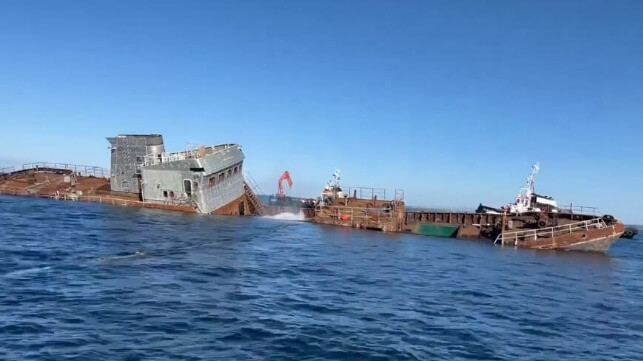Video: Smuggler Ship Sunk to Create Ireland’s First Artificial Reef

Irish authorities came up with a novel solution for what to do with a vessel long abandoned by smugglers which had become a burden. Seized a decade ago for smuggling, the vessel was used to create the country’s first artificial reef.
The MV Shingle had infamously been stopped by Irish authorities as part of an effort to break up a smuggling ring. The Customs and Revenue Commission captured the vessel in June 2014 while a crew was attempting to smuggle 32 million cigarettes and 4,500 kilograms of tobacco with a total retail value of approximately €14 million ($15.5 million). According to media reports, the vessel had sailed from Slovenia to Portugal, and as it neared the port of Drogheda, north of Dublin, the authorities apprehended the ship which was registered in Moldova.
The vessel which is 197 feet (60 meters) in length ended up becoming the custody of Revenue and required large amounts of money for berthing fees and maintenance. For nine years the vessel was moored at the Dublin port. Ireland’s High Court ordered the forfeiture of the vessel thinking it would be an asset that could be sold, but instead, the state found itself saddled with a rusting hulk. Last year they moved the vessel to New Ross port, but it was deemed no longer seaworthy. Tired of holding on to the ship that could not get a buyer, the problem was scrapping it was also going to be costly.
A local county councilor who is also a trained diver had been working he says since 2008 on the idea of creating a reef for diving. A group set up for the purpose, Killala Bay Ship 2 Reef, proposed the idea to the government and earlier this year won permission to proceed with the reefing. The Revenue Department donated the ship after reporting over the years, plus the remediation effort to make it ready for reefing, Shingle had cost about €2 million ($2.2 million) in berthing fees, maintenance, and remedial work. They had to remove asbestos and residual oils.
On Wednesday, September 18, the vessel was towed into position just over a mile from shore. It was sunk in a live broadcast and attracted many viewers and onlookers at the site. It was sunk to a depth of about 95 feet to the bottom of Killala Bay in the northwestern reaches of the country. The hope is that it becomes a marine life haven and international tourist attraction on the Wild Atlantic Way. The reef is also expected to provide opportunities for scuba divers, recreation, and marine research.
KBS2R highlights that the creation of Ireland’s first artificial reef responds to the need to create economically sustainable tourism that plays to the strengths of the natural environment and expands the offerings of the Wild Atlantic Way. Killala Bay lies between counties Mayo and Sligo and both county councils were quick to see the potential for tourism development and back the project.
No comments:
Post a Comment